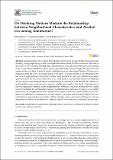Files in this item
Do drinking motives mediate the relationship between neighbourhood characteristics and alcohol use among adolescents
Item metadata
| dc.contributor.author | Martin, Gina | |
| dc.contributor.author | Inchley, Joanna Catherine | |
| dc.contributor.author | Currie, Candace Evelyn | |
| dc.date.accessioned | 2019-03-13T12:30:09Z | |
| dc.date.available | 2019-03-13T12:30:09Z | |
| dc.date.issued | 2019-03-08 | |
| dc.identifier | 258041936 | |
| dc.identifier | b1915370-23d7-4294-bbf3-8108b2d3bee2 | |
| dc.identifier | 85062884804 | |
| dc.identifier | 000462664200178 | |
| dc.identifier.citation | Martin , G , Inchley , J C & Currie , C E 2019 , ' Do drinking motives mediate the relationship between neighbourhood characteristics and alcohol use among adolescents ' , International Journal of Environmental Research and Public Health , vol. 16 , no. 5 , 853 . https://doi.org/10.3390/ijerph16050853 | en |
| dc.identifier.issn | 1660-4601 | |
| dc.identifier.other | ORCID: /0000-0001-8322-8817/work/65014215 | |
| dc.identifier.uri | https://hdl.handle.net/10023/17264 | |
| dc.description | Funding: Funding for the Scottish Health Behaviour in School-aged Children was provided by NHS Scotland. This work was also supported by the 600th Anniversary Ph.D. Scholarship which was awarded to Gina Martin by the University of St Andrews. | en |
| dc.description.abstract | Adolescents not only vary in their alcohol use behavior but also in their motivations for drinking. Young people living in different neighborhoods may drink for different reasons. The aims of this study were to determine if neighborhood characteristics were associated with adolescent drinking motives, and whether drinking motives mediate the relationship between neighborhood context and regular alcohol use. Data from the Scottish Health Behaviours in School-aged Children 2010 survey of students in their 4th year of secondary school were used. The study included 1119 participants who had data on neighborhood characteristics and had used alcohol in the past year. Students were asked questions about the local area where they lived, their alcohol use, and their motives for drinking alcohol, based on the Drinking Motives Questionnaire Revised Short Form (DMQR-SF). Multilevel multivariable models and structural equation models were used in this study. Coping motives showed significant variation across neighborhoods. Structural equation models showed coping motives mediated the relationships between neighborhood deprivation, living in an accessible small-town, and neighborhood-level disorder with regular alcohol use. Public health policies that improve neighborhood conditions and develop adaptive strategies, aimed at improving alcohol-free methods for young people to cope better with life’s stresses, may be particularly effective in reducing inequalities in adolescent alcohol use if targeted at small towns and areas of increased deprivation. | |
| dc.format.extent | 19 | |
| dc.format.extent | 1307483 | |
| dc.language.iso | eng | |
| dc.relation.ispartof | International Journal of Environmental Research and Public Health | en |
| dc.subject | Neighborhood | en |
| dc.subject | Deprivation | en |
| dc.subject | Drinking motives | en |
| dc.subject | Adolescence | en |
| dc.subject | Mediation | en |
| dc.subject | Multilevel | en |
| dc.subject | Urban | en |
| dc.subject | Rural | en |
| dc.subject | Social cohesion | en |
| dc.subject | Disorder | en |
| dc.subject | HV Social pathology. Social and public welfare | en |
| dc.subject | RA0421 Public health. Hygiene. Preventive Medicine | en |
| dc.subject | RJ Pediatrics | en |
| dc.subject | 3rd-NDAS | en |
| dc.subject | SDG 3 - Good Health and Well-being | en |
| dc.subject.lcc | HV | en |
| dc.subject.lcc | RA0421 | en |
| dc.subject.lcc | RJ | en |
| dc.title | Do drinking motives mediate the relationship between neighbourhood characteristics and alcohol use among adolescents | en |
| dc.type | Journal article | en |
| dc.contributor.institution | University of St Andrews. School of Medicine | en |
| dc.identifier.doi | https://doi.org/10.3390/ijerph16050853 | |
| dc.description.status | Peer reviewed | en |
This item appears in the following Collection(s)
Items in the St Andrews Research Repository are protected by copyright, with all rights reserved, unless otherwise indicated.

